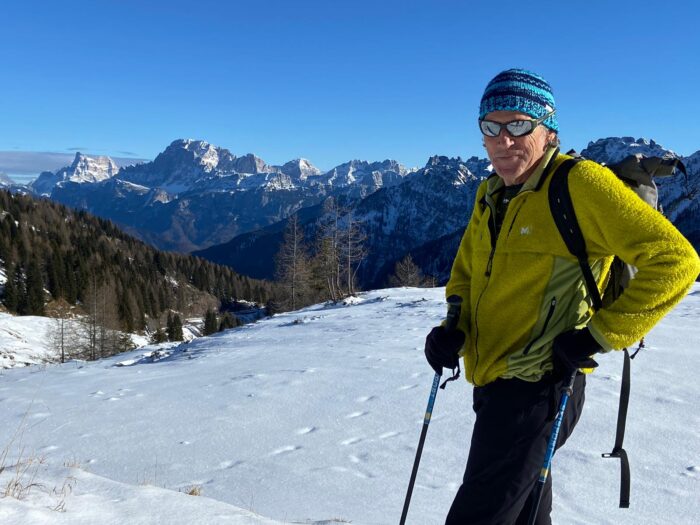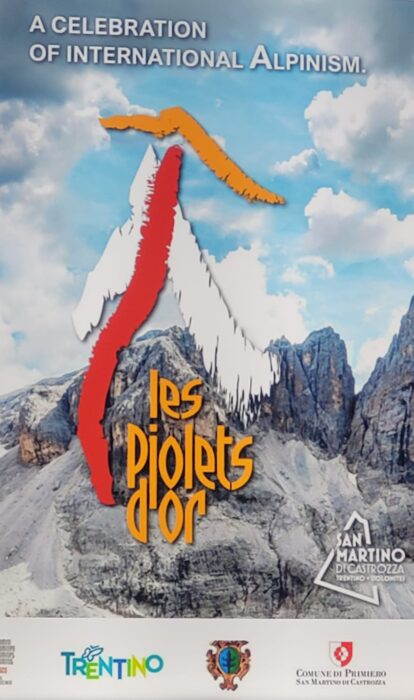The Piolets d’Or ceremony, held last Tuesday in San Martino di Castrozza, was not just about awarding climbs and climbers. Mountains and conditions on them are so different that how do you rank one or two expeditions above the rest?
On the surface, the three-day gathering, which always takes place in classy European mountain hubs — Chamonix sometimes, the Dolomites this year — may seem like a venue where aging veterans applaud competitive younger alpinists willing to risk their lives for a “best of the year” trophy. In fact, the organizers insist it is a celebration of the spirit of mountaineering. It is also a time to reflect on certain essential issues in alpinism.

Awarded climbers at a press conference before the final ceremony. Photo: Angela Benavides
Enhanced consciousness
“I wanted to make the impossible possible,” said American recipient Alan Rousseau. After watching the video of his team’s first alpine-style ascent of the north face of Jannu, his statement seemed closer to a statement of fact than to a promotional one-liner. The 2,700m Himalayan wall is simply insane. An endless face plastered with ice, vertical for most of its length and then, on the upper third, overhanging. Their climb was beyond superlatives.
Rousseau and partners Matt Cornell and Jackson Marvell described the four-day ascent. On the last two days, beyond exhaustion, they spoke of an “enhanced level of consciousness,” which included a phantom fourth member that all of them perceived, listened to, and accepted.
Some 100 vertical meters below the summit, one of the climbers discovered that his fingers were frostbitten. After a five-minute discussion, they decided to continue to the top. They stood on the summit for just a few minutes, already hallucinating.
After rappelling down the face for two days, they finally stepped onto the glacier beyond exhaustion.
“At the end of the last rappel, we had just one Camalot left, a couple of hooks, and no screws,” Rousseau said. Had they needed more than another two rappels, they would have been stuck.

Left to right, Matt Cornell, Jackson Marvell and Alan Rousseau. Photo: P. Drozdd/Piolets dOr
Interestingly, no one in the audience seemed too surprised by the ghost partner and the hallucinations. Several climbers in the small auditorium had likewise experienced such sort-of-supernatural happenings.
The Jannu team was not alone in mentioning that state of enhanced perception. The young Swiss trio of Hugo Begin, Nathan Monard, and Matthias Gribi also had that state of mind as they followed a series of ice funnels on the north face of Flat Top. They were completely uncertain whether they would find an exit to the summit or if their route would dead end at some point.
The fallen
Then came the moving presentation of The Secret Line, Kazuya Hiraide and Kenro Nakajima’s pioneering route on the north face of Tirich Mir. This was Hiraide’s fourth Piolet d’Or and Nakajima’s third, but neither was alive to receive it. They both perished this summer while attempting Hiraide’s lifetime dream: a new route up the West Face of K2.
As he explained in an interview with ExplorersWeb, Hiraide was slowly building toward K2 throughout the years.
“One mountain led me to the next,” he said, and all mountains led to K2. The younger Nakajima had become Hiraide’s partner after the death of Kei Taniguchi and accompanied him on that last fatal climb.

Kazuya Hiraide’s family and Tae Nakajima, at right. Photo: P. Drozdz/Piolets d’Or
Hiraide and Nakajima’s widows, Shoko and Tae, picked up their late husbands’ awards. In an awkward moment, Hiraide’s kids were also called onto the stage.
Shortly before, there was a minute of silence on behalf of the Japanese and other past Piolet d’Or winners who died in the mountains this year: Sergey Nilov, hit by a falling serac while trying to retrieve the body of his partner (killed in 2023) on Gasherbrum IV, and Archil Badriasvili of Georgia, struck by lightning while climbing at home in the Caucasus at only 38. Badriashvili’s sister Rushka was also present.
This harsh reminder of death in the mountains and its terrible collateral damage for the climbers’ loved ones showed the flip side of extreme alpinism. High-level triumphs often only occur at the risk of death. The consequences of these risks are too grave to ignore.
Quiet climbers
The awards for life achievement and for female mountaineering (a new category this year) were good examples of how not all climbers are driven by the same ambitions or attracted to the same kind of goals.

Jordi Corominas ski touring near San Martino di Castrozza the day after the ceremony. Photo: Christian Trommsdorff/Piolets d’Or
Jordi Corominas, who received a lifetime achievement Piolet d’Or, is virtually unknown. Google acknowledges him mainly for the first repetition of K2’s Magic line in 2004 and for his work as a mountain guide. He refuses to use social media and rarely checks WhatsApp or even turns on his phone. He avoids exposure, ignores the media, and minimizes public appearances. His world is the corner of the Spanish Pyrenees, where he lives and climbs daily.
No wonder he is a listener and a reader rather than a speaker. Few know he has opened dozens of routes on high mountains, especially in the Andes, including first ascents of Siula Chiko, Cerro San Lorenzo, and Chakraraju East.
A decade before Jimmy Chin and Conrad Anker made Meru Peak in the Garhwal Himalaya famous, thanks to their award-winning film Meru, Corominas opened a new route on Meru East. His resumé also includes Thalay Sagar, Dhaulagiri solo in light style…and a number of other climbs he has not bothered to publicize.
Yet his reputation as one of the main figures in contemporary Spanish alpinism hangs mainly on his work as a guide and adviser to young climbers: from the national team of young alpinists to his mentorship of a young trail runner and skimo racer who once asked his advice on how to get started on the 8,000’ers: Kilian Jornet.
A special woman
Nives Meroi is the first Italian and second woman ever to complete the 14×8,000’ers without supplementary oxygen or sherpas. But she has also attempted a number of new routes and still managed to climb some 8,000’ers the lonely way. She first attempted K2 from its North Side in China and finally summited with husband Romano Benet via the Abruzzi Spur in 2006.
“We were completely alone without ropes on the Bottleneck, as no one had climbed the mountain that year or the year before,” Meroi recalled. “We called our K2 expedition ‘K for 2′ and have wonderful memories of it.”
She received her Piolet d’Or, in particular, for her 2023 first ascent of Kabru South, a 7,000m peak in the Kangchenjunga area, with partners Romano, Peter Hamor and Bojan Jan.
Meroi has climbed over 90% of her mountains with Romano Benet. Asked by journalists at the Piolets about dealing with the 8,000m world as a woman, she saw it as no problem.
“Unlike sport climbing, where men and women are equally gifted, in high altitude alpinism, men have a physical advantage, thanks to greater strength and size. But we women have other skills that we use…We don’t climb better or worse, we just climb big mountains differently.”
She insists that gender is no excuse not to climb in style. “Style is the combination of ethics and aesthetics,” she says.

Nives Meroi. Photo: P. Drozdz/Piolets d’Or
After four decades, the Piolets d’Or remains a vital yearly reminder for the climbing community about what’s important. It is not about ranking climbs but reminding us that alpinism is a human passion that extends beyond sport, records, and egos. It is a path to an enhanced level of consciousness and a way to live our fragile lives to the fullest.

Piolet d’Or poster. Photo: Angela Benavides






